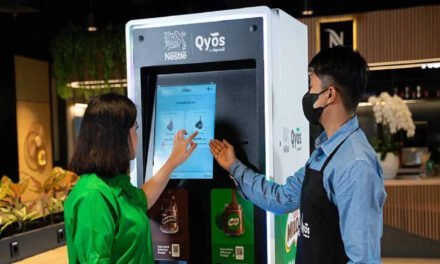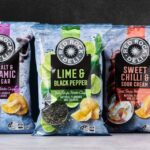In this article, we shall embark on a journey to explore five inspiring stories of food and beverage rebranding that harnessed the power of branding to revitalise their image and remain competitive in the market.
In today’s dynamic and fiercely competitive marketing landscape, branding has emerged as a pivotal force that can make or break a product or company. Branding serves as the very launching pad for marketing and promotional efforts. Over the course of the preceding decades, branding has transcended mere logos and slogans; it has become a strategic tool that shapes consumer perceptions, drives loyalty, and ultimately fuels success.
Within the ever-evolving world of food and beverage, one must not underestimate the power of branding. A strong and resonant brand can breathe new life into a struggling product or reposition a company for success. In this article, we shall embark on a journey to explore five inspiring stories of food and beverage brands that harnessed the power of branding to revitalise their image and remain competitive in the market.
Also Read: List of Top 10 Food and Beverage Billionaires
Also Read: Top Plant-Based Meat Companies in India
Five inspiring stories of food and beverage rebranding

1. PepsiCo: A Refreshing Rebrand
PepsiCo, a global beverage and snack giant, faced the challenge of connecting with a new generation of consumers who were becoming increasingly health-conscious and looking for more minimalist and contemporary branding. In response, PepsiCo initiated a daring journey of rebranding to keep pace with changing consumer preferences. The transformation featured a revamped logo and packaging design. The new look featured a simplified, dynamic, and youthful design that resonated harmoniously with the evolving tastes of its intended audience. This extensive rebranding effort allowed PepsiCo to maintain its competitive edge and establish itself as a contemporary brand in the highly competitive beverage industry.
Updated Logo and Packaging:
The most prominent change was the rejuvenation of the PepsiCo logo. It retained its iconic globe shape but incorporated a more contemporary design with vibrant colours, symbolizing a renewed outlook. The packaging of many PepsiCo products underwent a facelift, placing a premium on clarity and simplicity.
Focus on Health and Wellness:
Responding to growing consumer demand for healthier options, PepsiCo repositioned some of its key brands. It introduced innovative products with reduced sugar and sodium content and a commitment to reducing the environmental impact of its packaging. Notable acquisitions of health-centric brands further cemented this strategic shift.
Sustainability Initiatives:
PepsiCo made a significant commitment to sustainability. The company aimed to reduce its carbon footprint, increase the use of recycled materials, and promote responsible sourcing of ingredients. These endeavours were communicated prominently in the rebranding efforts to highlight the company’s dedication to a greener future.
Diversification:
Beyond traditional carbonated soft drinks, PepsiCo diversified its product portfolio to include a wide range of snacks, juices, and healthier alternatives. This diversification helped the company cater to changing consumer preferences and market trends.
Community Engagement:
PepsiCo actively engaged with local communities and focused on social responsibility. Initiatives supporting education, agriculture, and employment were integrated into the rebranding campaign, showcasing the company’s commitment to making a positive impact beyond just profits.
Also Read: Top 10 Technologies Transforming Food Processing
Also Read: Top 10 Health Food Manufacturing Companies in the world

2. Domino’s Pizza: From “Pizza Delivery” to “Pizza Innovation”
Domino’s Pizza recognised that they needed a fundamental change to compete in the fiercely competitive pizza delivery market. To execute this transformation, they initiated a transparent rebranding campaign. They candidly acknowledged prior quality issues and committed to improving their recipes and menu options. Moreover, they shifted their focus from the erstwhile famous “You Got 30 Minutes” delivery promise to one emphasising quality and innovation. This strategy alteration restored consumer trust and transformed Domino’s into an industry leader known for its commitment to quality and innovation.
Transparency and Honesty:
Domino’s kicked off its rebranding campaign with a bold move by acknowledging the shortcomings in the quality of its pizza. The company’s “You Said, We Listened” campaign openly admitted its faults and committed to making significant improvements. This transparency and honesty resonated with customers and set the stage for transformation.
Menu Innovation:
Domino’s invested heavily in menu innovation. It introduced a range of new pizza flavours and toppings, including artisanal and gourmet options. This menu diversification went beyond the traditional delivery fare, positioning Domino’s as a destination for culinary exploration.
Digital Transformation:
Recognising the importance of technology in the modern pizza ordering experience, Domino’s made substantial investments in digital platforms. The company revamped its website and launched a user-friendly mobile app that allowed customers to easily place orders, track their pizzas in real-time, and provide feedback.
Pizza Tracking and Delivery:
Domino’s introduced the iconic “Pizza Tracker” tool, allowing customers to follow the entire pizza-making process, from dough preparation to delivery at their doorstep. This innovation not only improved transparency but also added an element of excitement to the customer experience.
Customer Engagement:
The brand actively engaged with customers on social media, leveraging platforms like Twitter and Facebook to address feedback, respond to inquiries, and even incorporate customer-generated content in their marketing campaigns. This two-way communication fostered a sense of community and loyalty.
Global Presence:
Domino’s rebranding efforts globally ensure a consistent brand image and customer experience across different countries. This global approach helped Domino’s remain a recognizable and reliable pizza brand worldwide.
Sustainability:
Domino’s also embraced sustainability by focusing on eco-friendly packaging and sourcing high-quality, responsibly produced ingredients. This commitment to sustainability appealed to environmentally conscious consumers.
Also Read: Top 10 Best Food Companies in Europe 2025
Also Read: Top 15 Food Companies in USA: A Comprehensive List

3. Hershey’s: A Sweet Transformation
Hershey’s, a beloved chocolate and confectionery brand, embarked on a rebranding journey to modernise its image while preserving its heritage. In this endeavour, they introduced a refreshed logo and packaging design, seamlessly integrating a more contemporary and vibrant visual identity. Furthermore, Hershey’s also expanded its product line to include healthier snack options to cater to changing consumer preferences. This strategic rebranding initiative achieved the remarkable feat of not only trapping the hearts of its loyal customer base but also capturing the imagination of new generation chocolate lovers.
Product Diversification:
Hershey’s expanded its product portfolio beyond its classic chocolate bars. The company introduced new products, including variations of its famous chocolate bars, different flavour combinations, and even non-chocolate confections. This diversification allowed Hershey’s to cater to a broader audience and tap into emerging consumer trends.
Modernized Packaging:
Hershey’s updated its packaging to convey a more contemporary and appealing image. While retaining its signature brown and silver branding, the packaging now includes clear and vibrant imagery, making it easier for consumers to identify products and understand their contents.
Health-Conscious Choices:
Hershey’s introduced products with lower sugar content and portion-controlled packaging, acknowledging the growing demand for healthier options. This move demonstrated the brand’s commitment to offering choices aligned with consumers’ health-conscious lifestyles.
Sustainability Initiatives:
Hershey’s embarked on sustainability initiatives by investing in eco-friendly packaging and sourcing responsibly produced cocoa. These efforts showcased Hershey’s commitment to environmental responsibility, an increasingly important consumer factor.
Global Expansion:
Hershey’s expanded its global presence by acquiring and partnering with confectionery companies in different regions. It helped the brand reach new markets and cater to diverse consumer preferences worldwide.
Digital Engagement:
Hershey’s engaged with consumers through digital marketing and social media campaigns. This interactive approach allowed the brand to connect with a younger, tech-savvy audience and build a robust online presence.
Brand Transparency:
Hershey’s emphasized transparency in ingredient sourcing and production processes. This transparency built trust with consumers, who increasingly wanted to know the origins and quality of the products they consumed.
Also Read: Top 10 Ice Cream Brands in USA: The Guide for Ice Cream Lovers
Also Read: Top 5 Food & Nutrition Technology: Watchlist for 2025 and Beyond

4. Starbucks: Brewing Success Through Evolution
Starbucks, the global coffeehouse chain, acknowledged the need to adapt to shifting tides of consumer preferences and the rise of speciality coffee competitors. In response, they underwent a comprehensive rebranding initiative that included redesigning their stores for a more welcoming and community-oriented atmosphere. Concurrently, Starbucks also diversified its menu, offering a broader range of beverages and food items, emphasising quality and sustainability. This strategic metamorphosis not only fortified Starbucks’ leadership but also resonated with the diverse customer base.
Diverse Menu Innovation:
Starbucks recognised the need to cater to broader consumer preferences. Beyond its signature coffee offerings, the brand expanded its menu to include an array of teas, iced beverages, food items, and even alcohol in select locations. This diversification allowed Starbucks to appeal to a broader audience and increase its daily relevance.
Digital Engagement:
Starbucks leveraged technology to enhance the customer experience. The Starbucks mobile app, for example, introduced features like mobile ordering and payment, allowing customers to skip the line and personalise their orders. This tech-savvy approach appealed to a younger, digitally connected demographic.
Global Sustainability Initiatives:
Starbucks demonstrated a commitment to sustainability by sourcing ethically and responsibly grown coffee beans. The brand also embarked on initiatives to reduce its environmental footprint, such as incorporating eco-friendly packaging and reducing waste. These efforts resonated with socially conscious consumers.
Community Involvement:
Starbucks actively engaged with local communities through its “Starbucks Community Stores” program and initiatives like the “Starbucks College Achievement Plan.” These initiatives demonstrated the brand’s commitment to positively impacting society beyond its coffee offerings.
Inclusive Spaces:
Starbucks aimed to create inclusive and welcoming spaces in its stores. Initiatives like “Race Together” and “Third Place” encouraged open dialogues on social issues and positioned Starbucks as a place for community engagement and dialogue.
Design and Store Concept Evolution:
Starbucks introduced modern store designs and concepts, moving away from the traditional coffeehouse aesthetic. This evolution gave customers a fresh and inviting atmosphere, reflecting a contemporary lifestyle.
Cultural Relevance:
Starbucks remained culturally relevant by collaborating with artists, musicians, and designers and by embracing local cultures in its global locations. These partnerships and cultural nods helped the brand connect with a diverse customer base.

5. McDonald’s: Evolving with the Times
McDonald’s, an undisputed global fast-food leader, recognised the importance of adapting to changing consumer preferences and societal concerns about health and sustainability. In light of this recognition, they initiated a comprehensive rebranding effort that included introducing healthier menu options, a meticulous overhaul of their restaurants with a more modern and inviting aesthetic, and emphasising food sourcing and quality transparency. This strategic rebranding aimed to position McDonald’s as a more health-conscious and environmentally responsible brand, catering to a diverse and discerning customer base. The culmination of this monumental effort not only helped McDonald’s maintain its market leadership but also contributed to enhancing its brand perception.
Healthier Menu Options:
In response to growing concerns about health and nutrition, McDonald’s has expanded its menu to include healthier choices. It includes options like salads, fruit slices, and grilled chicken, offering customers a broader range of selections beyond its classic burgers and fries.
Sustainability Initiatives:
McDonald’s has made significant commitments to sustainability, aiming to reduce its environmental impact. These initiatives include sustainable sourcing of ingredients, recycling programs, and transitioning to eco-friendly packaging materials, demonstrating the brand’s commitment to environmental responsibility.
Modernized Store Designs:
McDonald’s has been redesigning its store layouts and aesthetics to create a more modern and inviting atmosphere. The updated designs incorporate features like touchscreen kiosks for convenient ordering and digital menu boards for a contemporary feel.
Tech Integration:
McDonald’s has embraced technology to enhance the customer experience. Introducing mobile ordering and delivery services through apps and third-party platforms allows customers to enjoy McDonald’s products with added convenience.
Localized Offerings:
McDonald’s recognises the importance of catering to regional tastes. The brand often introduces menu items tailored to local preferences, respecting cultural diversity and enhancing its appeal to a global customer base.
Community Engagement:
McDonald’s has initiated community engagement programs and philanthropic efforts, like the Ronald McDonald House Charities. These initiatives reflect the brand’s commitment to giving back to the communities it serves.
Transparency and Communication:
McDonald’s has tried to enhance transparency regarding its ingredients and food sourcing. It has also embraced social media as a means to communicate directly with customers and address concerns.
In conclusion, these case studies illustrate the various strategies and approaches that food and beverage brands can employ during the rebranding process. Whether through a bold visual overhaul, a commitment to transparency, or a shift in messaging and tone, rebranding can breathe new life into established brands and secure their relevance in an ever-changing market.
Each of these brands recognized the need for change and executed their rebranding efforts effectively, ultimately achieving success in their respective niches. These brands not only survived but thrived by acknowledging the need for change and embracing it, proving that a well-executed rebrand can be a recipe for success in the world of food and beverage.
‘Processed Food Industry’: The Voice of Food Processing Industry
Processed Food Industry (PFI) is a premier English-language monthly B2B publication (ISSN 09721649) headquartered in New Delhi, catering to the vibrant and ever-evolving food processing industry. While we don’t claim to be the largest or most widely read, our proud legacy of over 27 years—publishing continuously since 1997—has earned us the trust of industry professionals as a reliable source of insights and information.
If your goal is to tap into the booming Indian and South Asian markets to promote your equipment, technology, software, or consumables, PFI is your strategic partner. With our hybrid approach across print, web, and social media, we help you establish strong brand recognition rooted in market relevance. Backed by a team of top-tier technical writers, we’re ready to work closely with you and your customers to craft compelling content that drives results.
India and South Asia’s food industry is expanding rapidly, driven by efficiency and cutting-edge innovations. Don’t miss the opportunity to elevate your brand and engage with this dynamic market. Get our 2025 media kit to fine-tune your marketing strategy, increase your visibility, and convert potential customers into valuable conversations. Additionally, ask for a sample copy of our monthly magazine and experience the quality and relevance we deliver.
Let us help you define your role in the future of the food processing industry.
Have a news or topic to share with industry? Write to us editorial@pfionline.com

















